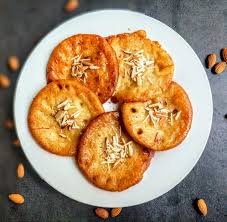The Crispy, Syrupy Sweet That Feels Like a Festival
If you’ve ever strolled through the lanes of North India during Holi or Diwali, you’ve probably noticed something magical—huge iron kadhais bubbling with ghee, the smell of cardamom and fennel floating through the air, and shopkeepers carefully ladling golden discs into sugar syrup. Those golden discs are malpuas, and just the sight of them makes you forget everything else.
For me, malpua is not just a sweet—it’s a celebration. It’s the smell of childhood festivals, the sound of laughter in the kitchen, and the sight of my grandmother carefully dropping batter into hot ghee, warning us kids not to come too close. We would wait impatiently for that first bite—the edges crispy, the center soft and fluffy, dripping with syrup. It wasn’t just food; it was a memory being created.
So, what exactly is malpua? In simple terms, it’s India’s answer to a pancake—except instead of maple syrup, it’s dunked in fragrant sugar syrup, and instead of butter, it’s fried in pure ghee. And like everything in Indian cooking, malpua comes in many forms, with every region giving it its own twist. Today, I’ll walk you through the classic North Indian style malpua, talk about its variations, and share tips so yours turn out just like the ones from the halwai’s (sweet maker’s) shop.
What is Malpua, Really?
At its heart, malpua is a deep-fried dessert pancake. The batter is made with flour, sometimes khoya (reduced milk) or mashed bananas, flavored with fennel seeds and cardamom. When poured into hot ghee, the batter spreads out into thin, lacy circles. The magic is in the contrast—crispy edges, soft centers.
Once fried, the malpuas take a quick dip in hot sugar syrup. The syrup seeps into the pores of the pancake, giving it that shiny glaze and sweet stickiness. In many homes, malpua is served with a generous scoop of rabri (thickened, sweetened milk). If you’ve never had that combination, trust me—it’s a match made in heaven.
Malpua Across India
The beauty of Indian food is that one dish can take on dozens of forms. Malpua is no different.
- In Bihar and Uttar Pradesh: Malpua is made with a flour-milk batter, sometimes with a little mashed banana. It’s a Holi essential.
- In Rajasthan: Malpua often includes khoya (mawa) in the batter, making it richer and creamier. It’s also a staple at weddings.
- In Odisha: Malpua is part of the famous Chappan Bhog offered to Lord Jagannath. Here, it can include rice flour and coconut.
- In Bengal: Winter malpuas are often flavored with jaggery instead of sugar, giving them a deep, earthy sweetness.
Whichever version you taste, one thing remains constant: malpua always feels festive.
Ingredients for Classic Malpua
The list is simple—nothing fancy, but when combined, they create something magical.
For the Batter:
- 1 cup all-purpose flour (maida)
- ¼ cup semolina (sooji/rava) – gives a slight crispiness
- ¼ cup khoya (optional, for richness)
- 1 cup milk – adjust as needed
- 2 tablespoons sugar
- 1 teaspoon fennel seeds (saunf), lightly crushed
- ½ teaspoon cardamom powder
- A pinch of baking soda (optional, makes them airy)
For the Sugar Syrup:
- 1 cup sugar
- ½ cup water
- A few strands of saffron (optional, for fragrance)
- ½ teaspoon cardamom powder
For Frying:
- Ghee – for authentic taste (you can use oil, but ghee is traditional and much tastier)
Optional Topping:
- Rabri (thickened milk)
- Chopped nuts like pistachios or almonds
Step-by-Step Recipe
Step 1: Make the Sugar Syrup
Before you start frying, prepare the syrup so it’s ready.
- In a pan, add sugar and water. Heat until the sugar dissolves.
- Let it simmer until you get a slightly sticky consistency (not too thick, not too thin).
- Add saffron and cardamom powder. Keep it warm.
Tip: If the syrup crystallizes, just add a spoon of water and heat it again.
Step 2: Prepare the Batter
This is the base of your malpua.
- In a bowl, mix flour, semolina, sugar, khoya (if using), fennel seeds, and cardamom.
- Gradually add milk, whisking to make a smooth batter. It should be of pouring consistency—not too thick, not too runny. Think pancake batter.
- Let the batter rest for at least 30 minutes. This helps the flavors develop.
Step 3: Fry the Malpuas
Now comes the fun part!
- Heat ghee in a flat pan or kadhai. The ghee should be medium hot—not smoking.
- Take a ladleful of batter and pour it gently in the center. It will spread into a small circle.
- Fry on medium heat until the edges turn golden and crisp. Flip and cook the other side.
- Remove and immediately dip the malpua into warm sugar syrup for a few seconds.
- Place on a plate, sprinkle some chopped nuts, and serve hot.
Tip: Don’t overcrowd the pan. Fry one or two at a time so they cook evenly.
Serving Malpua
Freshly fried malpua, dipped in syrup, and topped with a drizzle of rabri is a dessert that feels like pure indulgence. The combination of crispy edges, syrupy sweetness, and creamy rabri is almost addictive. Even without rabri, malpuas taste divine with just a sprinkle of nuts.
Serve them hot if you want that fresh-from-the-pan crispness, or slightly warm if you prefer them softer and fully soaked in syrup.
Variations of Malpua You Can Try
Once you know the basics, you can play around with flavors.
- Banana Malpua: Add mashed bananas to the batter. This is popular in Bihar and Bengal.
- Rajasthani Malpua: Add khoya and cream for a richer, denser version.
- Jaggery Malpua: Replace sugar with jaggery in the batter or syrup for a rustic taste.
- Coconut Malpua: Mix grated coconut into the batter. Delicious and aromatic.
- Stuffed Malpua: Some people stuff malpua with a khoya filling before frying—an indulgent twist.
Tips for Perfect Malpuas
- Resting the batter is important. It makes the malpuas fluffy and flavorful.
- Temperature of ghee is key. Too hot, and they burn; too cold, and they turn greasy.
- Always dip in warm syrup, never cold, otherwise the syrup won’t stick.
- Serve fresh. Malpuas taste best on the same day.
Why Malpua Feels Special
Malpua isn’t just about taste—it’s about the moment. It’s about making the first batch on Holi morning when the whole house is buzzing with excitement. It’s about the aunties in the kitchen sharing stories while stirring the batter. It’s about kids sneaking in to grab one straight from the syrup tray.
In that sense, malpua is more than food—it’s tradition, love, and nostalgia, all rolled into a crispy, syrupy circle.
So the next time you’re craving something sweet, skip the store-bought desserts. Make malpua at home. Yes, it takes a little effort, yes it’s indulgent, but trust me—it’s worth every bite.

